CAN NHRA DRAG RACING HELP INDY CAR SERIES FIX ITS PROBLEM?

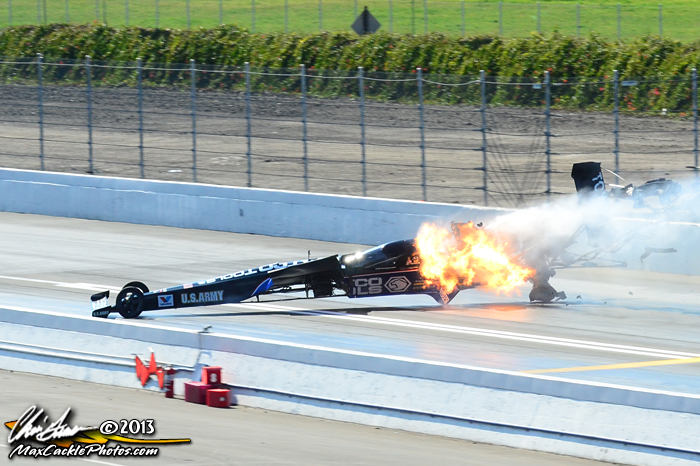
The Top Fuel brain trust at the NHRA’s Don Schumacher Racing didn’t realize it until they started looking at the video frame by frame.
In the second of Antron Brown’s two nasty crashes at Pomona, the front wing of his Matco Tools Dragster ripped loose when it rammed the wall. It shot up toward the cockpit and stabbed at the half-inch-thick ballistic polycarbonate canopy that sheltered him. Brown escaped relatively unscathed and expressed gratitude for the canopy that many had criticized and doubted.
Proven to be neither a performance-enhancer nor a detriment but certainly a lifesaver so far, the controversial canopy is in the spotlight again. This time many in the drag-racing community are wondering in the wake of Justin Wilson’s freakish, fatal on-track IndyCar incident at Pocono Raceway if DSR’s research and development might help open-wheel drivers.
Italy’s Dallara Automobili designs and produces the chassis for the Indy Racing League’s Verizon IndyCar Series. Dallara engineers declined to speak with Competition Plus in its visit this past week to the factory at Speedway, Ind. A spokesman said the company is preparing a statement in response to Wilson’s passing, but so far it has not issued any public comment.
Despite any official information about the nature of Wilson’s situation, it is clear the popular British racer was struck in his helmet by debris – widely assumed to be the hefty nose cone – from Sage Karam’s wrecked car.
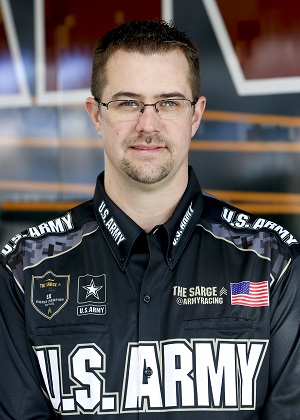
Neal Strausbaugh, U.S. Army Dragster assistant crew chief, is the right-hand man to crew chief Mike Green, who oversaw the canopy project at DSR and worked with Indianapolis-based canopy manufacturer Aerodine Composites. Strausbaugh was careful not to suggest the IndyCar Series develop and mandate its unique version of the canopy, especially without extensive knowledge of those cars, among a host of unknowns. However, he can vouch for the reliability of the device, at least in these infant stages.
“You could tell it had been severely hit but not compromised,” Strausbaugh said of the canopy after Brown’s crash. “It didn’t tear a hole in it. It worked flawless. It took us awhile to figure out what it hit. Antron will tell you he never saw it, never heard it, never knew any of it.
“We only knew it from video, and it was very, very difficult to see in the video, because it happened so fast,” he said, adding chances were great that without the cockpit cover, the double-edged-dagger of the sheared-off wing could have reached Brown with disastrous consequences.
Tested by fury, fire, and financial fears, the bolt-on structure is optional in NHRA competition but readily available to Top Fuel racers.
Strausbaugh said he can envision it being useful in open-wheel racing.
“From just an Indy Car outsider/fan perspective, I would hope that they would look into it, open up the rules to allow it, just like what NHRA has done,” he said. “And if people choose to do it, great. At this point, we’re open to any and all questioning. All we can explain is how we did it.”
Strausbaugh would tell interested IndyCar Series folks about the 11-pound fire-suppression and the fresh-air systems necessary with a canopy. (He said he thinks even non-canopy NHRA Top Fuel cars should be required to have those.) He would show them the knockout panels on the side of the body that allow an emergency crew to, in his words, “blow a nozzle right through that” because “it’s designed to break out so they can put a fire out.” He would explain the latches that enable someone to open the canopy from the inside or the outside. He would discuss the thought process behind the decision to go with a half-inch thickness (thinner than an F-16 fighter jet’s 7/8-inch-thick windshield) and driver visibility. He would share that the windshield alone weighs nine pounds.
IndyCar Series concerns aside, Strausbaugh said, “I think more people in the NHRA should have it.” However, even after the canopy appears to have absolutely no performance disadvantage with record-setting runs, victories, and championships, none of the non-believers have converted.
He said no one has approached him following Wilson’s death, ready to take a second look at the notion of a canopy.
“I absolutely anticipated it after Antron’s first crash. Since no one has done it, I’ve kind of thrown my hands up in any anticipation of what others might do,” Strausbaugh said.
That won’t stop him from being alert to new safety measures or curious about what open-wheel applications for the canopy might be.
The only real look Strausbaugh said he has taken at an open-wheel car cockpit had nothing to do with canopy research but rather leg-protection measures. So he indicated he is no expert on those race cars.
However, he said, “The difference with NHRA is our cockpits are very closed up, even without a canopy. It’s a small hole in the top. It has a full windshield in front of you. So visually, it doesn’t look as different from a canopy car to a non-canopy car,” he said. “If you put an enclosed cockpit on an IndyCar, yes, it’s going to look different. My personal thought is they would look awesome with one. I think they’re really close to having one in the body shape already. If you look at the way the car’s built, it looks like it would accept one very well. It would look very sleek, very aero, and not very heavy. I think it could be half the size of the Top Fuel canopy to cover what they would need to cover.”
A DILEMMA FOR BUILDERS
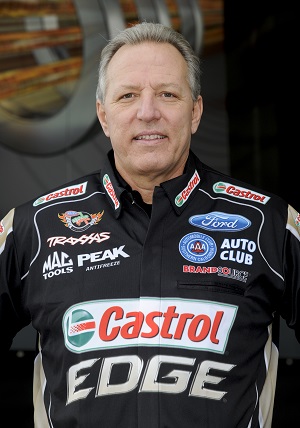
Dallara designers and NHRA chassis builders Murf McKinney, Brad Hadman, Aaron Brooks, and the engineers at Kalitta Motorsport and DSR all wrestle, at least somewhat, with one unique element: the idea that the car breaks apart during a crash, to disperse the energy and take it away from the driver. The dilemma is that while that protects the driver/s in an accident, it puts other, non-involved drivers at risk.
Strausbaugh said drag-racing fabricators struggle with that issue “to some degree.” However, the dynamics are different between drag racing and IndyCar racing.
With a Top Fuel dragster, “The front and back halves are designed to leave in a crash. They’re strong enough today you don’t see a lot of that happening. The back halves are stronger, but they are designed to break away. If you look at the SFI specs, the chassis is built to get the mass of the engine away from the driver’s compartment. I doesn’t always happen in every accident, but it does do that.”
Aerodine Composites President Craig McCarthy said, “You’d hate to protect a driver from that one-in-a-million [incident] and maybe make it worse for that one in a thousand.”
No matter what precautions anyone takes, occasionally nothing works.
As with the late Dan Wheldon’s IndyCar catastrophe at Las Vegas Motor Speedway, injuries from an accident are sometimes – to borrow IndyCar’s description – “non-survivable.”
Said Strausbaugh, “If you hit a solid structure with our windshield at 100 miles an hour with a 2300-pound car, will that windshield withstand that force? I doubt it. But what would?”
He wouldn’t bet against the canopy in a case such as Formula One racer Felipe Massa’s. Massa was seriously injured several years ago during the Hungarian Grand Prix when a suspension spring from competitor Rubens Barrichello’s wrecked car struck the visor of his helmet. He has recovered fully from a skull fracture and eye injury. But his incident occurred just days after Formula Two racer Henry Surtees died from head injuries after being struck by an errant tire from another driver’s crash.
Massa, incidentally, told Jonathan Noble of Motorsport.com that he pledged his help in any effort to improve cockpit safety but said, “I don't know if an enclosed cockpit is the right solution.”
Strausbaugh said regarding the Top Fuel canopy, “If we knew the velocity of that spring that entered the cockpit of the F1 car, we could fire a spring at this thing – and I think it would take that.”
NHRA crew chief Todd Smith works with Brittany Force’s canopy said in drag racing. “It’s so rare to have things come inside the cockpit. Those guys [in IndyCar] crash a lot more than we do.” Regardless, he has accepted team owner John Force’s decision to install a canopy and has adjusted well.
McCarthy said IndyCar racers can take comfort in knowing that in Wilson’s case, he wasn’t the victim of a poorly manufactured part or poorly designed car.
“Not that there’s any good at all with any of this,” he said, “but you can look at it and say, “That’s really a one-in-a-million chance that happened. It’s not like something in the car broke. He was at the wrong place at the wrong time. From a current driver’s perspective, to finish out the season [this weekend at Sonoma, Calif.], that’ll make them rest easy. There’s always something – it’s racing. We see some pretty weird stuff. And Sunday [with Wilson’s situation] was a good example of that.”
Indicating Wilson’s fate is not as utterly unpredictable as we’re encouraged to believe, McCarthy said, “As a businessman and a fan, it’s like, ‘How many more hits can they take?’ That’s where I think there may be some kind of compromise. I’m not fully committed to telling you I think a canopy on an IndyCar is the best thing ever. But I do think there is some sort of compromise, where they go with maybe a ballistic-grade windscreen that’s taller, something like that.”
Tethering larger parts of an IndyCar, such as the nose cone, is an option that sanctioning body might study. But, McCarthy said, “The first thing that’s going to happen is the teams are going to complain and mope because it takes them longer to change their noses out [during a pit stop]. The nose is designed for a very, very quick disconnect. That’s something that’s fairly new to the cars over the last 10 years. Now they can change the nose in eight seconds or something like that. It’s two quarter-turns on the tub and the whole nose comes off the car. So a tether would eliminate that. But maybe that’s what they need to do.
“Most of the things on the car are going to disintegrate on their own when they come off the car [in a crash]. You see plenty of that,” he said. “So really, it’s the nose and few pieces on the rear of the car that have some mass to them, that if they’re bouncing down the track could be a problem.”
STRIKING A BALANCE
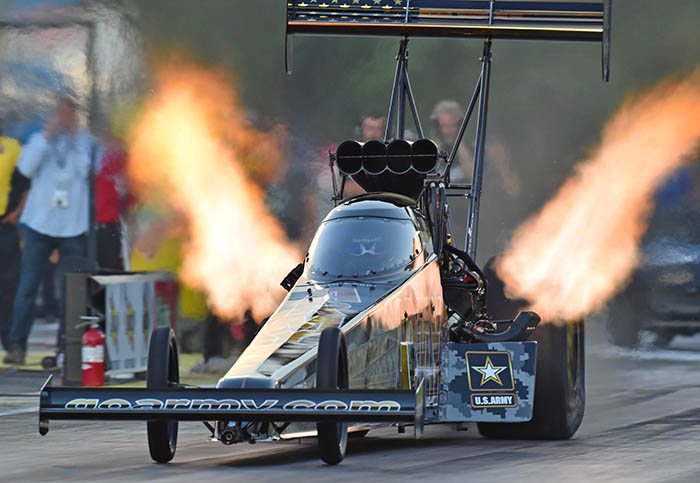 Like Strausbaugh, Smith understands that balance between safety and envelope-pushing. They often are opposite movements, and racers want both. So that turns into a problem for team owners who foot the bill, racers who are conflicted, and fans who have their own sets of demands.
Like Strausbaugh, Smith understands that balance between safety and envelope-pushing. They often are opposite movements, and racers want both. So that turns into a problem for team owners who foot the bill, racers who are conflicted, and fans who have their own sets of demands.
“We know from running [the canopy] on a drag car that once you enclose the cockpit, you’ve got to have fresh air and fire extinguishers. That’s extra stuff and extra weight, and nobody likes that, no matter what form of racing you’re in. When safety’s involved, sometimes compromises have to be made,” Smith said.
For some drivers, safety devices and costs are necessary evils, or at least they’re factors the racers at once genuinely want but also find annoying.
“There’s probably people out here who would drive without firesuits and helmets if it wasn’t mandated,” Strausbaugh said.
DSR was mindful to make sure the canopy didn’t interfere with performance (and on the fan side, entertainment).
“When we got this thing passed, it had to be raceable,” Strausbaugh said. “So there is always a balance between performance and safety – always. I don’t care what anybody says. We would wrap [Tony Schumacher] in ballistic steel if it didn’t matter. That’s why tanks go to war with ballistic armor.”
Former Funny Car mechanical magician Austin Coil once said the NHRA could order all sorts of safety gear on race cars and that would make them safer. But just as surely it would make them seem like tanks rather than race cars. And that would be completely unattractive to fans. No one would see anything thrilling – or make any money.
A LONG, COMPLEX PROCESS
No matter what, the process is laborious, and the IndyCar Series decision-makers would have to jump through the same input-gathering and tech-inspection hoops their NHRA brothers did. While information about the canopy from NHRA experts would be useful, IndyCar leaders would have to start from their own Square One.
McCarthy said, “For IndyCar, it’s a little different. It’s a spec series. It’s going to have to be more of an all-for-one mentality with them. It would be the sanctioning body pushing it down to the drivers, which would be interesting to see how that could go. But there are so many more factors involved with it over and beyond what we’ve dealt with with the NHRA.
“It just needs to be looked at, and I don’t know that it’s been properly looked at, at least this side of the pond,” McCarthy said, applauding efforts in Europe by both FIA and Mercedes. He expressed hope that IndyCar Series officials will work or have worked in conjunction with FIA and Mercedes to learn the results of their testing.”
McCarthy’s case in a nutshell is this: “With our company, and working with DSR, we’ve proved that you can successfully implement a canopy in a safe way in professional motorsports. Now, does it mean it’s one size fits all? There’s a lot of different constraints on the IndyCar guys. We’ve proved you can do it. The technology’s out there. I think it’s worth of discussion internally with IndyCar or externally with other companies looking to be involved in it. Is it the right way to go? I don’t know.
“It’s that emotional situation . . . The first thing that comes to my mind is go ask Simona de Silvestro if she wants one on her car. She almost burned alive twice in the past three years,” he said. “I can make an argument for it either way – and I certainly don’t ever want to make an argument against it.”
“It’s a lengthy process, unfortunately,” Smith said, “but it’s a big job for the sanctioning body to figure this stuff out an come up with something that pleases everybody. We had to change the entire aspect of everything. With IndyCars, I can only imagine . . .
Cost, McCarthy said, “is a big consideration. I think that’s one of the reasons it’s never really left the drawing board with IndyCar. They’re not unlike any other racing series: team owners just don’t want to spend any more money. It is extra cost. With an IndyCar, you’re talking about a complete retrofit of the car with a canopy system. Then you’re talking about other internal systems you have to have. Now the safety crew is going to have to be retrained. They’re going to have [new equipment] to train on, destroy, cut up, all that kind of thing. So the costs get bigger fast. And IndyCar’s not paying for that, I’m sure.”
(For Aerodine Composites’ projects with DSR, it provided samples to the NHRA Safety Safari emergency crew for training purposes – “maybe because were not the brightest bunch,” McCarthy joked, considering the expense his company absorbed for that.)
Smith said, “Some don’t want it to happen because of the costs and other factors.”
But the John Force Racing crew chief said teams need to ask, “What are we committed to the most? What’s important to us?”
He said he recognized that “it’s hard sometimes for individual teams to mandate something with their team when the rest of the field doesn’t have to [do it]. Then it is a money issue. Each individual team has to come up with the resources. That’s a big obligation for a team owner to take on.”
Said Smith, “Maybe [cost] is an issue, which is sad, because if you don’t do a safety product because of funding, I guess its shame on all of us. You should never be able to put a dollar on someone’s safety.”
Aerodine Composites, McCarthy said, “never went into it thinking” it would become wealthy with sales of cockpit canopies. “Let’s face it: Even if you sell one to everybody out there,” he said, “you’re still not setting the word on fire. For us, it was a purely safety thing.
“For the trouble it caused – and it was hard to get through that approval process – you ask yourself, ‘Was it worth it?’ Then when you have people like Antron come back from one of these crashes saying, ‘Man, You guys helped save my life,’ then yes, it’s worth it.”
TO COVER OR NOT TO COVER?
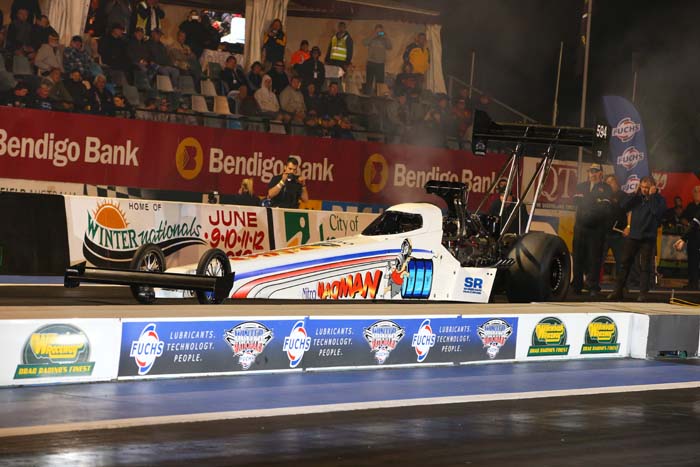
Richie Crampton, Morgan Lucas Racing Top Fuel driver and builder/mechanic, has built a canopy-covered dragster for Australian Mark Sheehan. But Crampton contentedly remains one of the majority not using it on the dragster he drives in the Mello Yello Drag Racing Series.
“I understand the layout of the DSR canopy car. I’ve sat in one a lot during the process of building one at our shop. They’re great,” Crampton said. “But I don’t believe they’re a necessity just yet in Top Fuel. What we have right now suits what we’re doing.”
He said, “In drag racing, you’re not following other vehicles as frequently. You still can have objects come toward you from the front. The dragster that I drive has a roll cage that the chromoly tubing extends forward of your helmet line by quite a large amount. That’s combined with the fact we have a very steep-angled quarter-inch-thick windshield that’s very strong, theoretically to deflect anything that might be coming at you from the front. So I don’t think my racecar is as open as an IndyCar’s, as far as the driver’s head.
“A canopy is an option in Top Fuel in NHRA right now. We are opting not to use it,” Crampton said. “I’m not saying they’re a bad idea and that I’d never have one. We just feel that what I have currently is suitable for what I’m doing right now.”
Said Smith, “As long as racing has been around, we all know it’s been trial and error, unfortunately.” Smith said. “We work at these things and try to keep them safe and try to predict things that are going to happen. But unfortunately, you never can. It’s never perfect. It’s always evolving.”
Strausbaugh agreed: “At the end of the day, it’s our job as engineers to make sure we have every available safety option that’s known to man. As we all know, auto racing in general, there’s danger involved. But I sleep well at night, knowing we’ve done everything that we know we can do to make the car as safe as it possibly can be and still perform at its highest level.”
Surely IndyCar Series participants want the same. What, if anything, they will do following Wilson’s passing should unfold in the next weeks and months.
“I don’t know if anything will transpire because of it,” Smith said, not accusing IndyCar officials or teams of ignoring concerns. Instead, he said, “The IndyCar guys are smart guys. They probably have thought about all this at one point.” He said the drag-racing community has heard the arguments and seen the results.
“In the beginning, it was a lot of weight, and it’s in the wrong part of the car, right in the driver’s compartment. It was like adding 50 pounds or getting a bigger driver in there,” Smith said. “Over time, like we always do, we figured out how to lighten everything else on the car to compensate for the weight. We learned how to run the cars, and the end result is it’s a lot safer.”
Perhaps the IndyCar industry will decide the time and money investment is worth the effort. NHRA proponents say at the least it’s worth investigating.





































